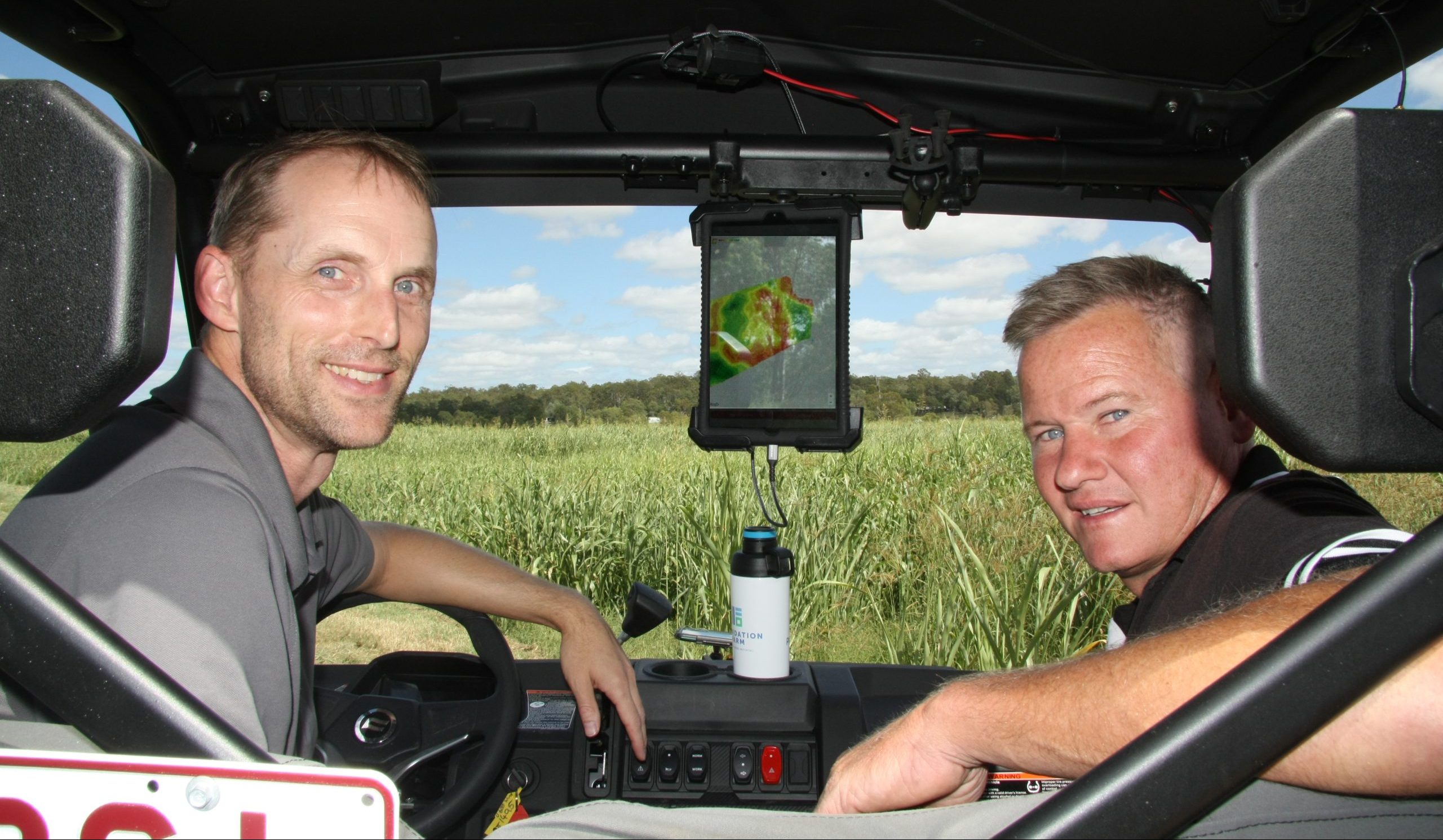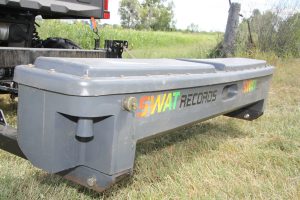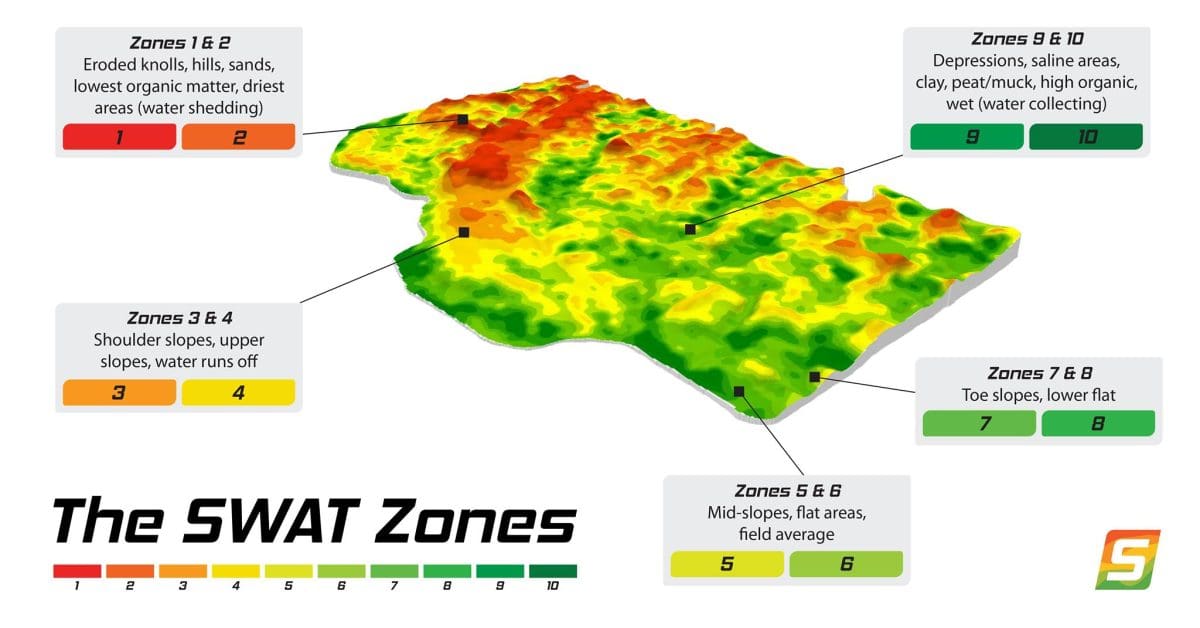
SWAT’s Wes Anderson (left) and Adam Proctor map a paddock on Pacific Farming’s Lockyer Valley holding.
AUSTRALIAN growers and agronomists can gain new insights into soil constraints through SWAT technology which builds on electro-magnetic and elevation data to show where and why crop yields are being limited, and guide variable-rate applications accordingly.
Developed by Canadian-based agtech company, Croptimistic Technology, SWAT’s patented maps and analysis are already widely used in Canada and the US, and are gaining traction in South Africa as well as Australia.
CT vice president of agronomy Wes Anderson last year relocated with his young family from Canada to Queensland’s Lockyer Valley to support existing business partners, and foster growth in SWATS’s newest market.
He said economic and environmental considerations were behind the uptake of SWAT software and hardware as growers looked to incorporate VR into their cropping systems, and the same drivers were at play in Australia and North America.
“High fertiliser prices have driven a renewed interest in agtech to help make better decisions, but it goes beyond that to seed, lime, gypsum, irrigation water, and even herbicides,” Mr Anderson said.
“There are environmental benefits to this in managing nutrients more responsibly, and also to help maximise irrigation water use or apply amendments only where needed.”
“At the end of the day, we are mapping soil variability and helping identify limitations to yield and what can be done to improve return on investment on applied inputs.”
From subsoil to agronomy
SWAT stands for soil, water, and topography, and its system starts with maps which integrate multiple layers of data.
They are generated via a SWAT box, which measures soil to a depth of about 80cm, or from EM38s, Topsoil Mappers or Veris data, provided it contains sufficient information.
The Croptimistic team then processes EM and real-time kinematic elevation data from the paddock map through the SWAT records software platform.
A SWAT box can be fitted to the back of a buggy or larger vehicle to gather data about soil and topography.

A SWAT box can be fitted to the back of a buggy or larger vehicle to gather data about soil and topography.
It generates multiple soil and water-related map layers that are then ground-truthed by a SWAT-certified agronomist, and a SWAT map that best represents the variability in the paddock is chosen.
This is typically followed by soil testing which guides VR nutrient prescriptions.
“Our modelling uses multiple layers of data which flows to our server for simplifying and processing, and is delivered back to the agronomist and farmer via SWAT RECORDS software.”
Mr Anderson said SWAT technology can also be used to guide seeding rates within a paddock.
“We’ve had a lot of success with VR seed in many crops in North America, and I’d expect similar advantages here in Australia in variable soil types.”
Mr Anderson said while the value of EM mapping to delineate soil types in a paddock has long been understood in Australia, SWAT maps helped to unlock some of the data’s messages, such as why high conductivity values exist for different reasons.

SWAT maps are generated using inputs including topographical and EM38 data. Source: Croptimistic Technology
SWAT maps are generated using inputs including topographical and EM38 data. Source: Croptimistic Technology
SWAT hardware and software is currently being trialled in Australia by Mr Anderson in collaboration with Pacific Farming, a Lockyer Valley fertiliser-spreading business, as well as by CropOpti Services in Horsham, Victoria, and MEAG Soil Science in Western Australia.
“Our two partners are actively mapping now, and I’m also mapping in south-east Queensland, and focusing on the Lockyer Valley for now.”
“I’m testing specific irrigation layouts, such as beds in bays with bankless channels, to see how the models work first.”
Encouraging results could well see uptake of SWAT for irrigated crops including cotton, where Mr Anderson gained experience while working for AGnVET in Griffith, New South Wales, in 2014-16, starting 13 years after he began his agronomy career.
Mr Anderson has been with CT since 2018.
“I have enough experience in cotton and rice to know there are some opportunities there, and some companies in Africa are having success using SWAT with sugarcane.”
However, Mr Anderson said he saw the initial uptake for SWAT in Australia being in dryland cropping, based on the similarity of farming systems between the Canadian prairies and Australia’s slopes and plains.
SWAT’s customer base in North America is using the technology primarily with canola, cereal, corn, pulse and soybean crops.
Expanding platform
SWAT hardware and software can work in with other precision-agriculture platforms, including John Deere’s, and the Bayer-owned FieldView, which on February 7 announced it would be launching in Australia.
“Currently we have an application programming interface with John Deere, and with FieldView to bring application and yield data into SWAT RECORDS, as well as share some base layers back to those platforms.
“They are additional tools that can add value, especially uploaded prescription files to JD ops so farmers have one less thing to worry about.”
To further add to the SWAT suite, in-house green-on-green imagery is close to launch.
“We are just launching SWAT CAM, a first-of-its-kind crop and weed autonomous imaging device that can be mounted to sprayers to collect in-crop data.
“It uses machine-learning algorithms to distinguish between crops and weed-leaf cover, and will soon be able to do plant counts in some crops as well.”
Grain Central: Get our free news straight to your inbox – Click here


HAVE YOUR SAY